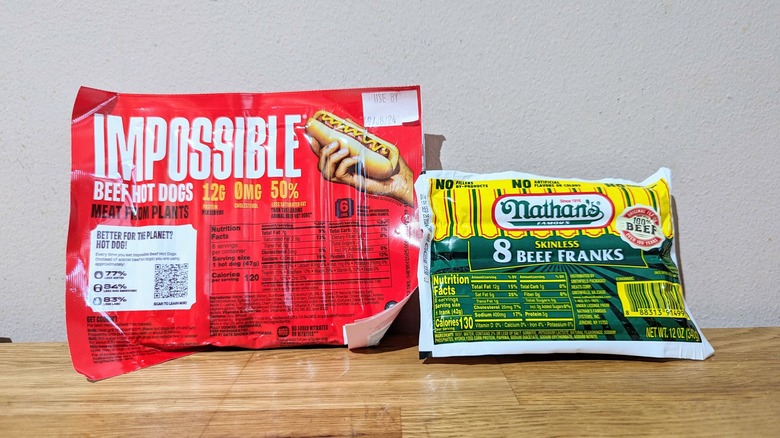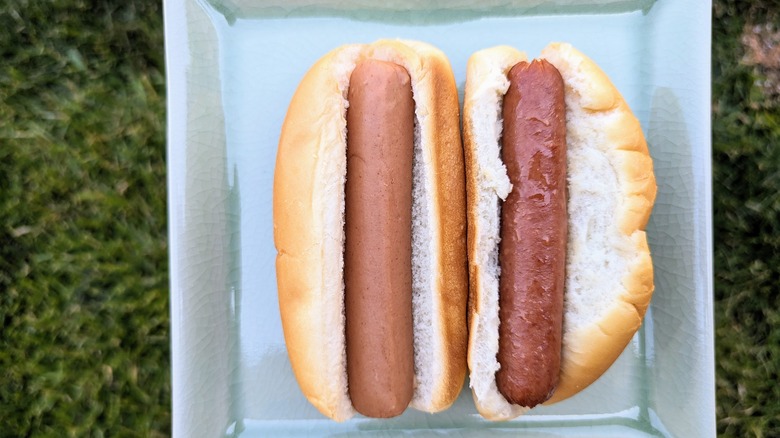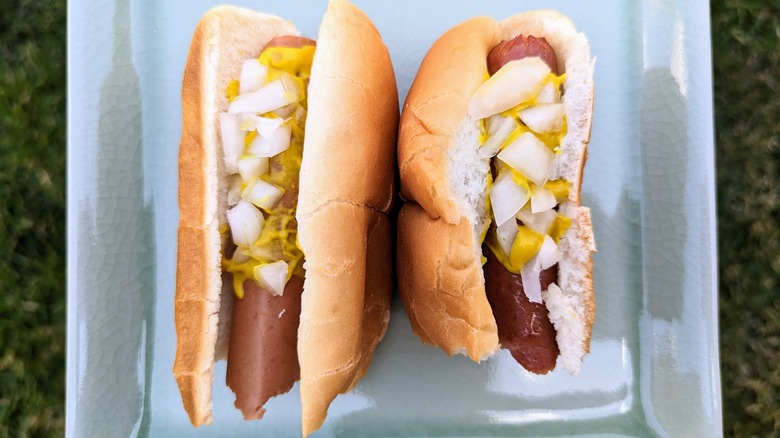Impossible Foods Hot Dogs Can't Quite Measure Up To The Real Thing
There's been some unexpected fuss about hot dogs this summer. We've recently learned that championship eater Joey Chestnut won't be competing in the Nathan's Famous Hot Dog Eating Contest this year.
Chestnut can't compete because he reportedly inked a sponsorship deal with Impossible Foods, a company that makes vegan beef, chicken, and pork substitutes — including hot dogs. It's the hot dog detail that's the problem, since participation in the Nathan's Famous Hot Dog Eating Contest requires contestants to have an exclusive relationship with Nathan's. Chestnut's new partnership creates a conflict of interest that excludes him from the Fourth of July event.
Impossible Foods hot dogs were released earlier this year, and now that Chestnut represents the meatless brand, we wanted to see how its new hot dogs stack up to the real thing. After all, if anyone knows the taste of hot dogs, it's Chestnut — if he can demolish 76 Nathan's Famous hot dogs in 10 minutes, there's no telling how many Impossible ones he could inhale. But are they actually any good? Since Impossible's dogs are supposed to be beef-flavored, we put them up against Nathan's skinless beef franks in this battle for hot dog supremacy. All prices quoted in this article were accurate at my local supermarket, but may vary depending on where you shop.
There's a key difference between Impossible Foods hot dogs and Nathan's Famous
In order to give each hot dog a fair shake, I simply steamed them and tried them plain at first. I love a char-grilled hot dog, but the char adds additional flavor, so I wanted to keep things simple.
Both hot dogs look like, well, hot dogs. The one on the left in the photo above is from Impossible Foods ($8.99 for a package of six) and the one on the right is from Nathan's Famous ($6.49 for a package of eight). As you can see, the Impossible Foods hot dog is a little lighter in color, but it looks like a typical skinless hot dog. The Nathan's is deeper in color and shows glistening beads of fat on its surface.
In terms of flavor, the Impossible Foods hot dog does taste remarkably like a hot dog. It's a little smoky and seasoned the same way as most hot dogs you've probably had, which is a net positive. However, its texture isn't great. This is a mushy hot dog with no bouncy chew. In the spectrum of hot dog textures, I'd liken it more to a mass-produced Oscar Mayer frank than a specialty hot dog from a butcher, or even a nice grocery store dog like Nathan's.
The Impossible dog also has a slightly bitter aftertaste, but not in a deal-breaking way. I still much prefer the Nathan's Famous, since it's got a more robust texture, better spice, and an overall beefiness that a vegan substitute just can't provide quite yet.
When you top the hot dogs, it's harder to tell the difference
Since most people top their hot dogs before eating them, I tested if doing so would level the playing field. I put some yellow mustard and raw onions on the remainder of each dog and gave them a try. The result was that both tasted like regular old hot dogs, though the softness of the Impossible Foods one was hard to ignore.
However, if someone was serving nothing but the Impossible ones at a backyard barbecue and hadn't told me they were vegan, I wouldn't give it a second thought — I'd assume they were regular hot dogs. They're fine, but not great. For a meatless version, they come close to the real thing in a respectable way, aside from their glaring mushiness.
If Impossible Foods decides to create its own hot dog eating contest to rival Nathan's Famous, I don't think Nathan's has anything to worry about yet, at least in terms of the way the dogs taste. Though since these Impossible ones go down with barely any chewing, Joey Chestnut could likely manage to eke a few extra down his gullet with less jaw fatigue. And after you've taken down a few dozen, I'd imagine the taste of the hot dogs is the last thing you'd be concerned about.
Impossible hasn't reinvented the vegan hot dog wheel here — it's just created a pretty decent meatless sausage. If it could have solved the texture problem, things might have ended up differently.


